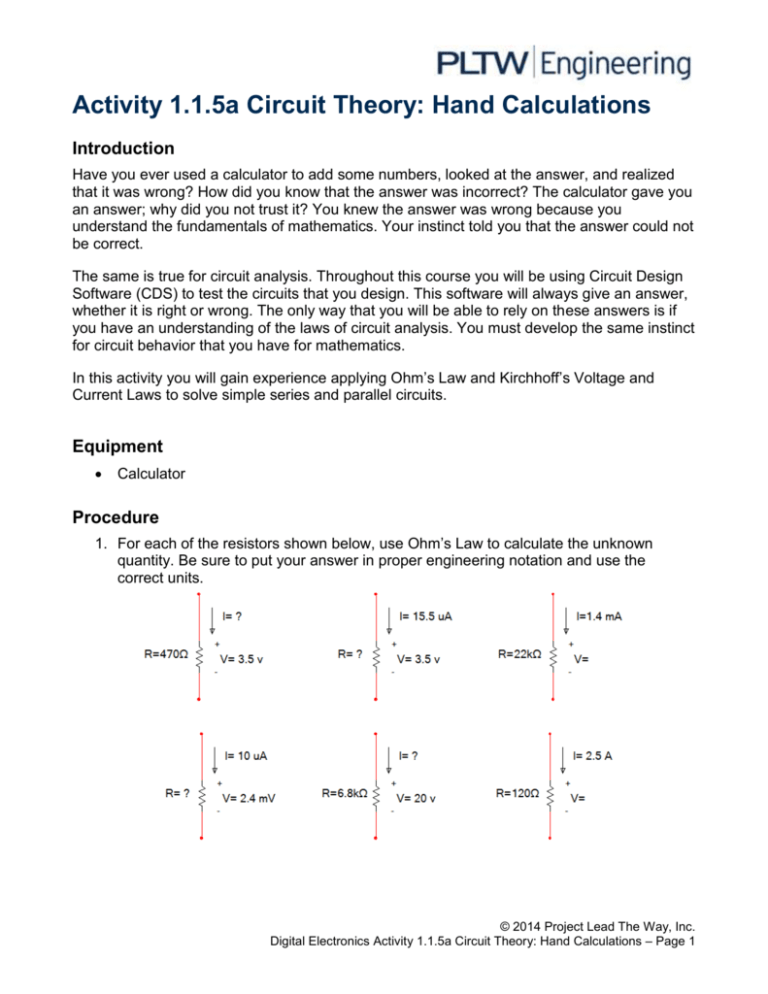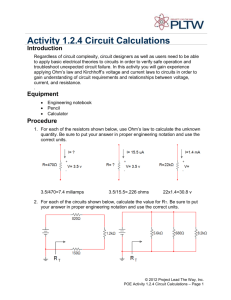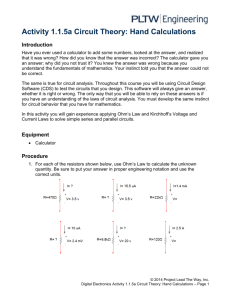1.1.5a Circuit Theory Hand Calculations
advertisement

Activity 1.1.5a Circuit Theory: Hand Calculations Introduction Have you ever used a calculator to add some numbers, looked at the answer, and realized that it was wrong? How did you know that the answer was incorrect? The calculator gave you an answer; why did you not trust it? You knew the answer was wrong because you understand the fundamentals of mathematics. Your instinct told you that the answer could not be correct. The same is true for circuit analysis. Throughout this course you will be using Circuit Design Software (CDS) to test the circuits that you design. This software will always give an answer, whether it is right or wrong. The only way that you will be able to rely on these answers is if you have an understanding of the laws of circuit analysis. You must develop the same instinct for circuit behavior that you have for mathematics. In this activity you will gain experience applying Ohm’s Law and Kirchhoff’s Voltage and Current Laws to solve simple series and parallel circuits. Equipment Calculator Procedure 1. For each of the resistors shown below, use Ohm’s Law to calculate the unknown quantity. Be sure to put your answer in proper engineering notation and use the correct units. © 2014 Project Lead The Way, Inc. Digital Electronics Activity 1.1.5a Circuit Theory: Hand Calculations – Page 1 2. For each of the circuits shown below, calculate the value for RT. Be sure to put your answer in proper engineering notation and use the correct units. Calculations: a) a) b) b) c) c) d) d) © 2014 Project Lead The Way, Inc. Digital Electronics Activity 1.1.5a Circuit Theory: Hand Calculations – Page 2 3. Using the laws of circuit theory, solve for RT, IT, VR1, VR2, & VR3. Be sure to put your answer in proper engineering notation and use the correct units. Using the calculations from problem (3), verify your results using Kirchhoff’s Voltage Law. 4. Using the laws of circuit theory, solve for RT, IT, VR1, VR2, VR3, & VR4. Be sure to put your answer in proper engineering notation and use the correct units. Using the calculations from problem (4), verify your results using Kirchhoff’s Voltage Law. 5. Using the laws of circuit theory, solve for RT, IT, IR1, IR2, & IR3. Be sure to put your answer in proper engineering notation and use the correct units. Using the calculations from problem (5), verify your results using Kirchhoff’s Current Law. © 2014 Project Lead The Way, Inc. Digital Electronics Activity 1.1.5a Circuit Theory: Hand Calculations – Page 3 6. Using the laws of circuit theory, solve for RT, IT, IR1, IR2, IR3, & IR4. Be sure to put your answer in proper engineering notation and use the correct units. Using the calculations from problem (6), verify your results using Kirchhoff’s Current Law. Conclusion 1. State two rules for the voltage and current in a series circuit. 2. State two rules for the voltage and current in a parallel circuit. 3. If you remove a single bulb from an inexpensive string of Christmas tree lights, all of the lights in the entire string will go off. Are the bulbs connected in series or parallel? Explain. Going Further – Optional The circuit shown below is a series/parallel circuit. That is, some of its resistors are connected in series and some are in parallel. Using the laws of circuit theory, solve for RT & IT. © 2014 Project Lead The Way, Inc. Digital Electronics Activity 1.1.5a Circuit Theory: Hand Calculations – Page 4









